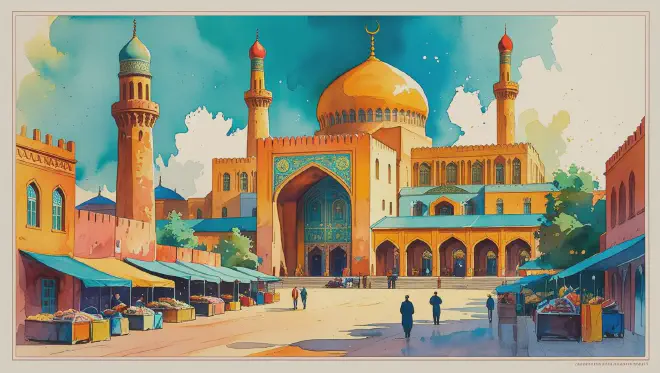Introduction
In the heart of Central Asia stands Ashgabat, the capital of Turkmenistan, a white marble city built on the edge of the Karakum Desert. This alabaster metropolis presents a curious harmony between ancient Silk Road heritage and contemporary architecture. The city’s name means “City of Love,” and true to its name, it embraces visitors with a uniquely gentle atmosphere.
Once a stronghold of the Parthian Empire, this land witnessed the passage of Alexander the Great’s armies and served as a crossroads for Silk Road caravans. Modern Ashgabat, with its buildings uniformly clad in white marble gleaming brilliantly under the desert sun, creates an almost surreal, mirage-like quality.
The traditional culture of the Turkmen people mingles with the faint salt breeze from the Caspian Sea and, above all, the profound silence that only the great desert can create. These elements blend together to form the city’s distinctive rhythm of time. A journey to Ashgabat, with its indescribable charm, surely leaves deep impressions etched in one’s heart.

Day 1: Gateway to the White City
The morning airport was quieter than I had expected. As I stepped onto the tarmac of Ashgabat International Airport, the dry air caressed my skin. Receiving my first taste of Central Asia’s continental climate, I settled into a taxi. The driver, Murad, smiled warmly and greeted me in broken English: “Welcome to Ashgabat.”
On the road into the city, I was overwhelmed by the view from the car window. An endless array of white buildings stretched toward the blue sky in perfect order. It felt like driving through a massive architectural model. When Murad proudly explained that everything was made of marble, I truly grasped the city’s extraordinary character.
After checking into my hotel, I ventured out in search of lunch. My first stop was a small chaikhana (tea house) bustling with locals. The owner, Ata, initially spoke to me in fluent Russian, but noticing my limited Russian, he switched to gestures and signs to explain the menu. I ordered manti (steamed dumplings) and plov (pilaf). The manti’s hand-rolled dough was perfectly tender, and the lamb filling was deeply flavored with aromatic spices. The plov had each grain of rice standing distinctly, with the sweetness of carrots and lamb melting harmoniously in my mouth.
In the afternoon, I walked toward the Independence Monument. This 118-meter white tower serves as a symbolic landmark visible from anywhere in the city. The area around the tower is a vast park where Turkmen families relaxed on the grass. The innocent laughter of children brought a warm sense of life to this desert city.
The panoramic view of Ashgabat from the tower’s observation deck was breathtakingly beautiful. White buildings arranged in perfect order stretched to the horizon, beyond which the vast Karakum Desert continued endlessly. Rarely do you find such a distinct boundary between city and desert. It was as if civilization and nature were engaged in dialogue.
In the evening, I dined at a traditional restaurant near my hotel. The interior was adorned with carpets and traditional Turkmen decorations, creating an exotic atmosphere. I ordered kebab and shashlik, enjoying them with Turkmen wine. The meat was grilled slowly over charcoal, crispy outside and juicy within. The wine was surprisingly fruity and smooth, revealing itself as a hidden gem of Central Asia.
Walking through the city at night, I noticed the buildings were illuminated. This created a fantastical beauty different from the daytime’s white brilliance. Few people walked the streets, and the entire city was enveloped in tranquil air. From the distance came the sound of a dombra (traditional instrument), adding depth to the night’s silence.
Day 2: Memories of Desert and Tradition
Early in the morning, I enjoyed breakfast on the hotel terrace while watching the sun rise over the desert. The orange light gradually painted the white buildings in pale pink, making the entire city seem to breathe with life. The traditional Turkmen breakfast included flat bread called nan, cheese, honey, and rich chai (tea). The bread was crispy and fragrant outside, with a chewy texture inside. The concentrated sweetness of local honey provided the perfect energy to start the day.
In the morning, I ventured to the outskirts to visit the ancient Parthian ruins of Nisa. This UNESCO World Heritage site contains fortress remains from the Parthian Empire dating to around the 3rd century BCE. The weathered walls and tower foundations spoke of the weight of long history. My guide, Gulban, had studied archaeology and explained every detail of the ruins with care. “This land has been an important junction connecting East and West for over two thousand years,” he said, highlighting the profound significance of the site.
From the top of the ruins, the vastness of the Karakum Desert left me speechless. Waves of sand stretching to the horizon constantly changed shape with the wind. Thinking that ancient peoples had gazed upon this same landscape filled me with wonder at the mysterious flow of time.
Lunch was at a small eatery near the ruins, where I tasted dograma (traditional Turkmen bread porridge). This simple dish of wheat flour and meat reflected the wisdom of people living in the harsh desert environment. Its warm, nourishing flavor soothed my travel fatigue.
In the afternoon, I returned to Ashgabat to visit the National Museum. This valuable institution offers systematic insight into Turkmen history and culture. Particularly impressive was the collection of hand-woven carpets. Turkmen carpets are world-renowned for their intricate geometric patterns and deep red colors. The craftsmanship and aesthetic sense woven into each piece moved me deeply. Maya, a museum curator, told me, “Carpets are our very souls,” revealing her profound attachment to tradition.
In the evening, I had the opportunity to visit a local carpet workshop. The sight of elderly women artisans weaving carpets using traditional methods was almost divine. The patience required for meticulous work that progresses only a few centimeters per day, continuing for months or even years, commanded my deepest respect. Bibikhan, the workshop’s matriarch, smiled as she taught me: “A carpet made in haste holds no soul.”
That night, I dined at a restaurant featuring traditional music and dance. The delicate sounds of the Turkmen dombra and the melancholy tones of the gijjek (two-stringed instrument) resonated deep within my heart. The dancers’ graceful movements seemed to express the flow of desert winds, creating a sense of unity with nature. Dinner’s ichlike oshi (lamb pilaf) was aromatic, with saffron lending beautiful golden color.
Day 3: Farewell and Eternal Memories
On my final morning, I spent quiet time on the hotel rooftop, gazing down at the city. White Ashgabat, illuminated by the morning sun, appeared like an island floating in a sea of clouds. Though my stay was brief at just two nights, I felt a mysterious bond with this city.
Before checking out, I wanted to walk through the city center once more. In the central square, I saw cleaning staff watering the streets from early morning, reflecting the citizens’ pride in keeping their city beautiful. The morning greeting “Salam aleikum” exchanged with passersby resonated pleasantly in my ears.
In the morning, for one last memory, I visited the bazaar (market). Altyn Bazaar serves as the center of local life, with colorful spices, fresh fruits, and handicrafts crowding the space. The merchants’ calls and price negotiations with customers created a vibrant atmosphere.
Particularly memorable was the sweet fragrance of Karakum melons. These melons, Turkmenistan’s pride, develop concentrated sweetness precisely because they grow in the harsh desert environment. When I tasted a slice, I was amazed by the intense sweetness and rich aroma unlike anything I had experienced before. The vendor’s description as “a gift from the desert” was perfectly fitting.
For lunch before heading to the airport, I returned to the chaikhana once more. At the same shop I had visited on my first day, owner Ata was pleased: “You came back again!” For my final meal, I ordered gatlama (thin Turkmen flatbread) with yogurt and sweet chai. Though simple, this meal seemed to concentrate all the time I had spent in this city.
In the taxi to the airport, driver Murad asked, “How was Ashgabat?” Though expressing myself in English was challenging, when I answered “Beautiful, peaceful,” he nodded with satisfaction. His words, “I’m happy you liked our city. Come back anytime,” warmed my heart.
During my final moments at the airport, waiting for departure, I reflected on this journey. Despite lasting only two nights and three days, it had left deep impressions. The beauty of the white buildings, the majesty of the desert, and above all, the warmth of the people. The kindness that transcended language barriers and the pride they held for their land touched my traveler’s heart profoundly.
Looking down at Ashgabat from the departing aircraft’s window, it sparkled like a white jewel in the desert. As I watched the cityscape recede, I was certain that the emotions and memories gained from this journey would remain in my heart for a lifetime.
Final Thoughts
This three-day Ashgabat travel account is an imaginary journey created by AI. It consists of encounters and experiences that never actually happened, constructed through extensive research and imagination. However, I strived to base descriptions of Turkmenistan’s culture, cuisine, people’s daily lives, and the desert environment on reality as much as possible.
Though imaginary, each time I reread this account, I feel as if I had truly been there. I’m struck anew by the wonder of traveling through written words and the vividness of memories created by imagination. Perhaps within our hearts already exists both longing for unseen lands and affection for the people we might meet there.
Should I ever truly visit Ashgabat one day, there might be moments when this imaginary journey overlaps with reality. Until then, these memories will continue to shine quietly in the depths of my heart.

